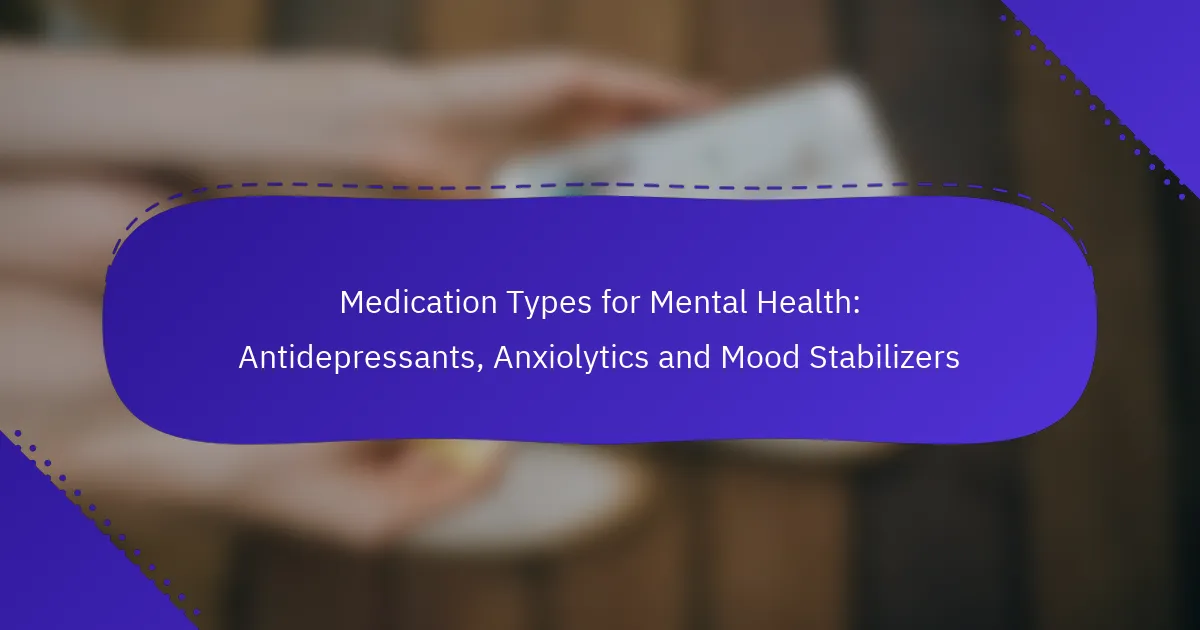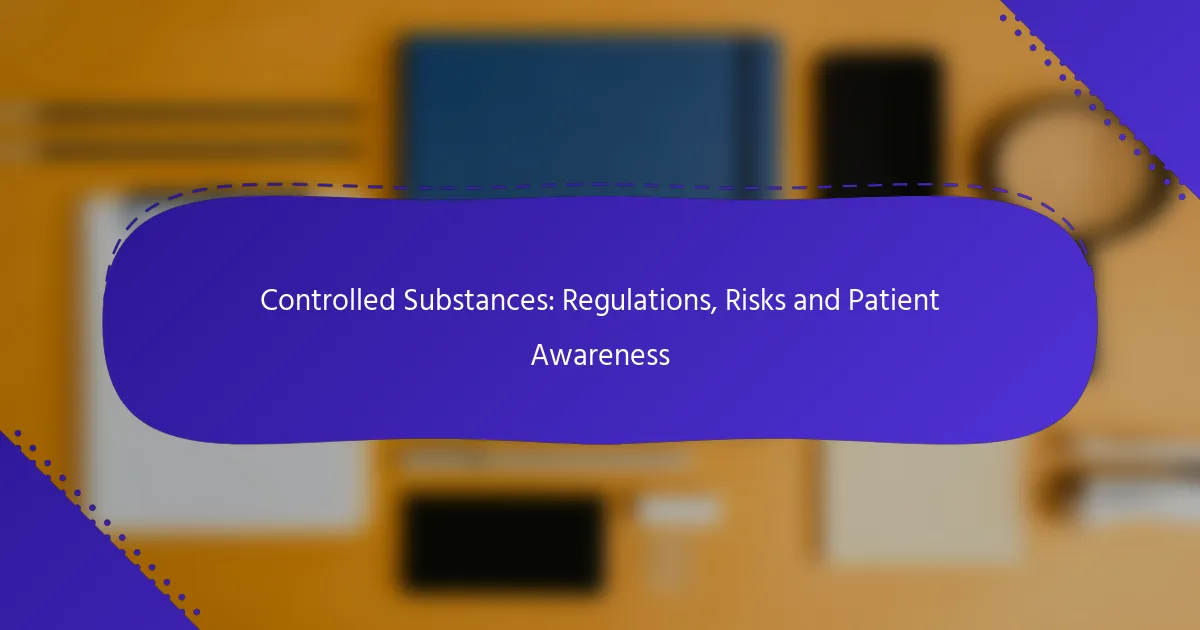Psichikos sveikatos gydymui naudojami trys pagrindiniai vaistų tipai: antidepresantai, anksiolitikai ir nuotaikos stabilizatoriai. Kiekviena kategorija atlieka specifinę funkciją, padedančią sumažinti simptomus ir pagerinti bendrą savijautą. Antidepresantai veikia keisdami neurotransmiterių pusiausvyrą smegenyse, o anksiolitikai dažniausiai skiriami trumpalaikiam nerimo simptomų palengvinimui.
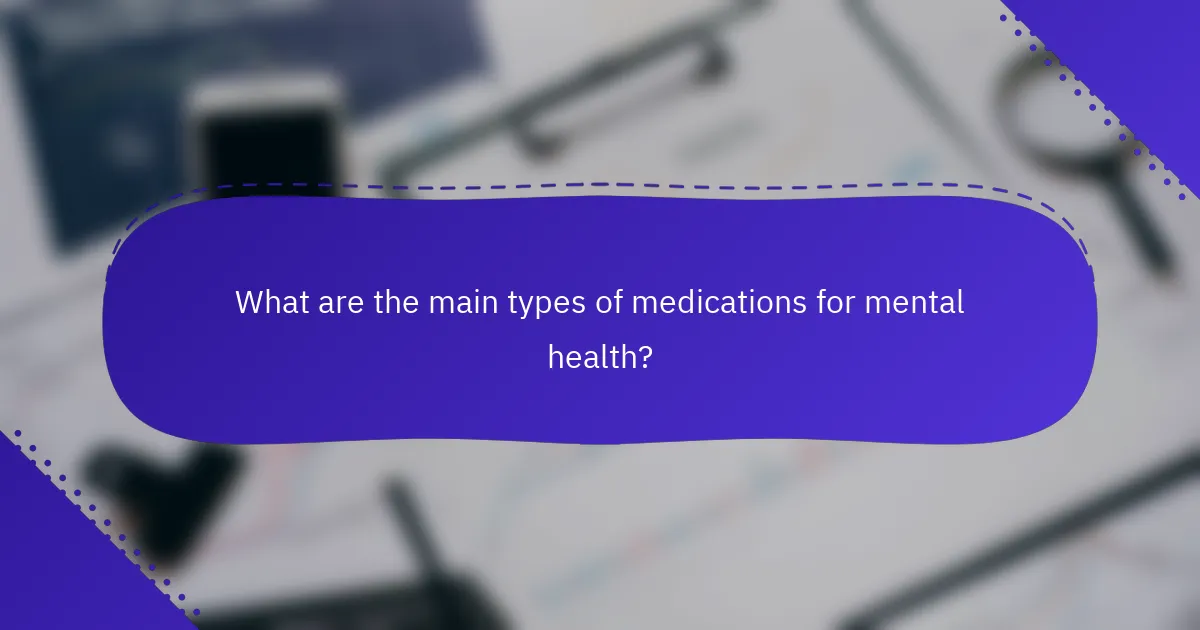
What are the main types of medications for mental health?
The main types of medications for mental health include antidepressants, anxiolytics, and mood stabilizers. Each category serves a specific purpose in treating various mental health conditions, helping to alleviate symptoms and improve overall well-being.
Antidepressants
Antidepressants are primarily used to treat depression and anxiety disorders. They work by balancing chemicals in the brain, such as serotonin and norepinephrine, which affect mood and emotional state.
Common types of antidepressants include selective serotonin reuptake inhibitors (SSRIs) and serotonin-norepinephrine reuptake inhibitors (SNRIs). It’s important to consult a healthcare provider to determine the most suitable option, as individual responses can vary significantly.
Anxiolytics
Anxiolytics are medications designed to reduce anxiety symptoms. They often provide quick relief and are typically prescribed for short-term use due to the potential for dependence.
Benzodiazepines are a common class of anxiolytics, effective in treating acute anxiety episodes. However, they should be used cautiously, and patients should follow their doctor’s guidance on dosage and duration to avoid withdrawal symptoms.
Mood Stabilizers
Mood stabilizers are used to treat mood disorders, particularly bipolar disorder. They help to stabilize mood swings and prevent episodes of mania and depression.
Common mood stabilizers include lithium and certain anticonvulsants. Regular monitoring of blood levels and side effects is essential when using these medications, as they can have significant impacts on physical health.
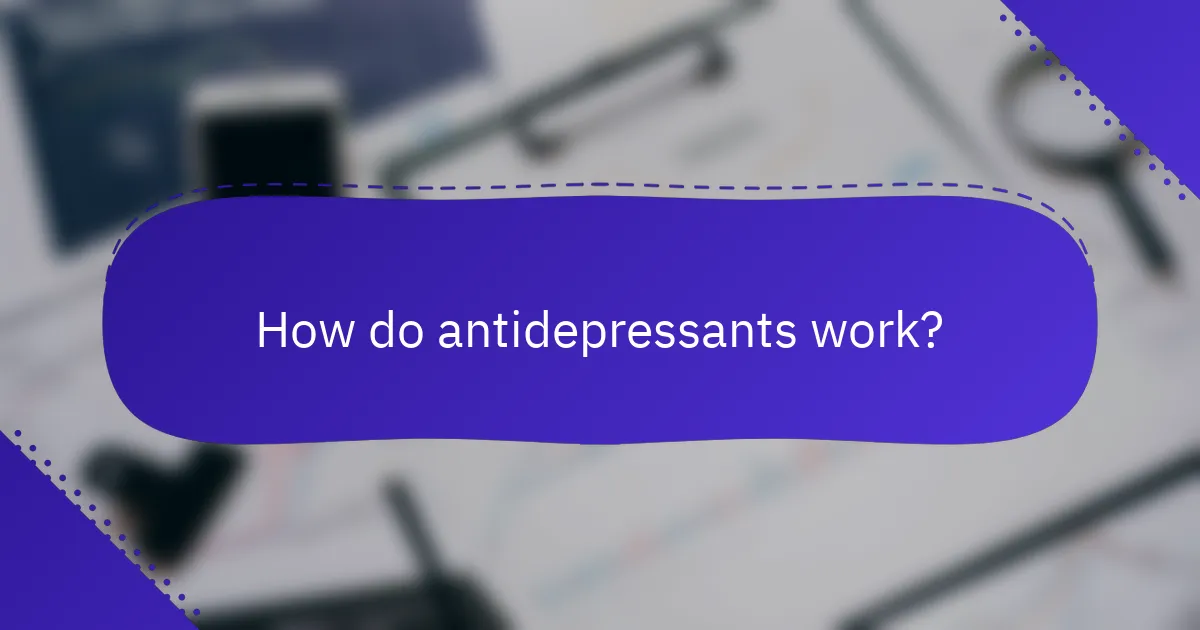
How do antidepressants work?
Antidepressants primarily function by altering the balance of neurotransmitters in the brain, which can help alleviate symptoms of depression. They target specific chemicals, such as serotonin and norepinephrine, to improve mood and emotional stability.
Serotonin reuptake inhibitors
Serotonin reuptake inhibitors (SSRIs) are a common class of antidepressants that increase serotonin levels in the brain by preventing its reabsorption into neurons. This leads to enhanced mood and reduced anxiety for many individuals. Examples include fluoxetine and sertraline.
When considering SSRIs, it’s important to be aware of potential side effects, such as nausea or insomnia, which may occur during the initial treatment phase. Typically, it may take several weeks to notice significant improvements, so patience is essential.
Norepinephrine-dopamine reuptake inhibitors
Norepinephrine-dopamine reuptake inhibitors (NDRIs) work by increasing the levels of norepinephrine and dopamine in the brain, which can help improve motivation and energy levels. Bupropion is a well-known example of this type of medication.
NDRIs may be particularly beneficial for individuals who experience fatigue or lack of motivation alongside depressive symptoms. However, they can also lead to side effects such as dry mouth or insomnia, so monitoring and communication with a healthcare provider are crucial during treatment.

What are the common anxiolytics used in Lithuania?
In Lithuania, common anxiolytics include medications that help alleviate anxiety symptoms. These drugs are typically prescribed for short-term relief and can be effective in managing anxiety disorders.
Diazepam
Diazepam, often known by its brand name Valium, is a widely used anxiolytic that works by enhancing the effects of a neurotransmitter called GABA. This results in a calming effect on the brain and nervous system, making it effective for treating anxiety, muscle spasms, and seizures.
When considering diazepam, it is important to be aware of potential side effects such as drowsiness, fatigue, and dependency with long-term use. It is generally prescribed for short durations, often in low doses, to minimize these risks.
Alprazolam
Alprazolam, commonly known as Xanax, is another popular anxiolytic that acts quickly to relieve anxiety symptoms. It works similarly to diazepam by increasing GABA activity, providing rapid relief for panic disorders and generalized anxiety.
Patients using alprazolam should be cautious of side effects, including dizziness and potential withdrawal symptoms if discontinued abruptly. It is typically prescribed for short-term use and requires careful monitoring by a healthcare provider to avoid dependency issues.
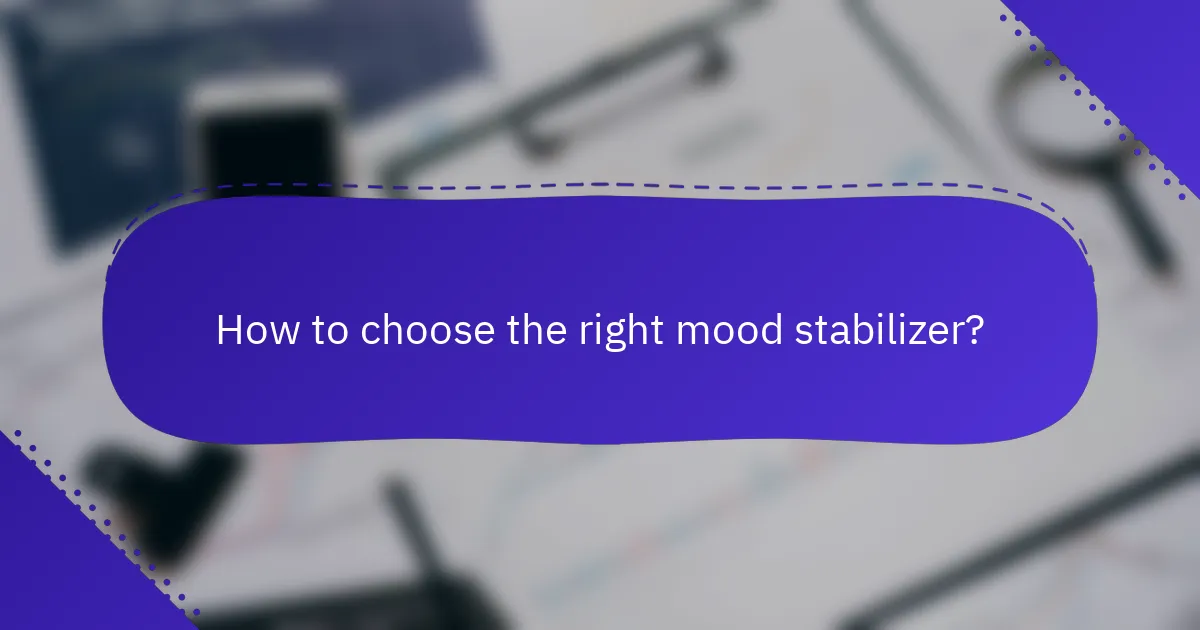
How to choose the right mood stabilizer?
Choosing the right mood stabilizer involves assessing your specific mental health needs, potential side effects, and professional guidance. It’s essential to work closely with a healthcare provider to find the most suitable option for your situation.
Consultation with a psychiatrist
Consulting with a psychiatrist is crucial when selecting a mood stabilizer. A psychiatrist can evaluate your mental health history, current symptoms, and any other medications you may be taking. This personalized assessment helps in determining the most effective treatment plan.
During the consultation, be open about your experiences and any concerns regarding mood fluctuations. This information allows the psychiatrist to tailor their recommendations to your unique needs, ensuring a better chance of success with the chosen medication.
Consideration of side effects
When selecting a mood stabilizer, it’s important to consider the potential side effects associated with each option. Common side effects may include weight gain, fatigue, or gastrointestinal issues, which can impact your daily life. Understanding these effects can help you make an informed decision.
Discuss with your psychiatrist the likelihood of experiencing side effects based on your health profile. Some medications may have a more favorable side effect profile, making them a better choice for certain individuals. Regular follow-ups can help monitor any adverse effects and adjust the treatment as necessary.
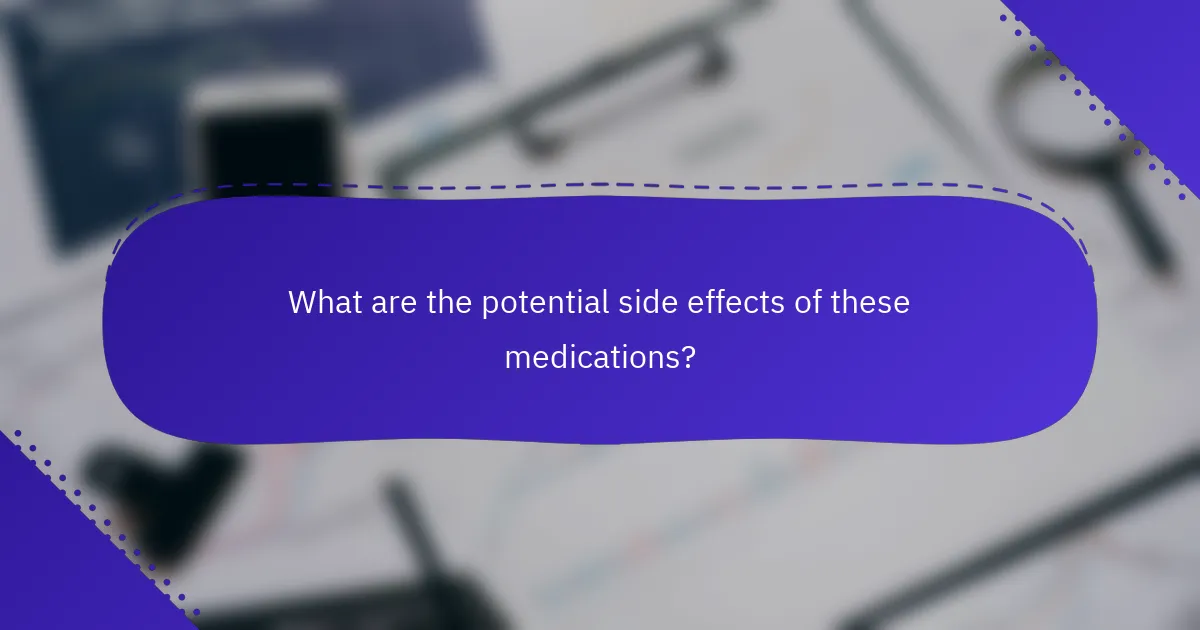
What are the potential side effects of these medications?
The potential side effects of antidepressants, anxiolytics, and mood stabilizers can vary widely, but common issues include weight gain, drowsiness, and withdrawal symptoms. Understanding these side effects is crucial for managing treatment effectively and making informed decisions about mental health care.
Weight gain
Weight gain is a frequent side effect associated with many antidepressants and mood stabilizers. Some medications can lead to an increase in appetite or changes in metabolism, resulting in significant weight changes over time.
Patients should monitor their weight regularly and discuss any concerns with their healthcare provider. Strategies to mitigate weight gain include maintaining a balanced diet and incorporating regular physical activity into daily routines.
Drowsiness
Drowsiness is another common side effect, particularly with anxiolytics and certain antidepressants. This sedation can affect daily activities, making it challenging to concentrate or perform tasks that require alertness.
To manage drowsiness, patients may need to adjust their medication schedule or dosage under the guidance of a healthcare professional. It is advisable to avoid driving or operating heavy machinery until the effects of the medication are fully understood.
Withdrawal symptoms
Withdrawal symptoms can occur when discontinuing antidepressants or anxiolytics, especially if the medication is stopped abruptly. Symptoms may include anxiety, irritability, dizziness, and flu-like symptoms.
To minimize withdrawal effects, it is essential to follow a healthcare provider’s recommendations for tapering off medication gradually. Patients should communicate any withdrawal symptoms they experience to their doctor for appropriate management.
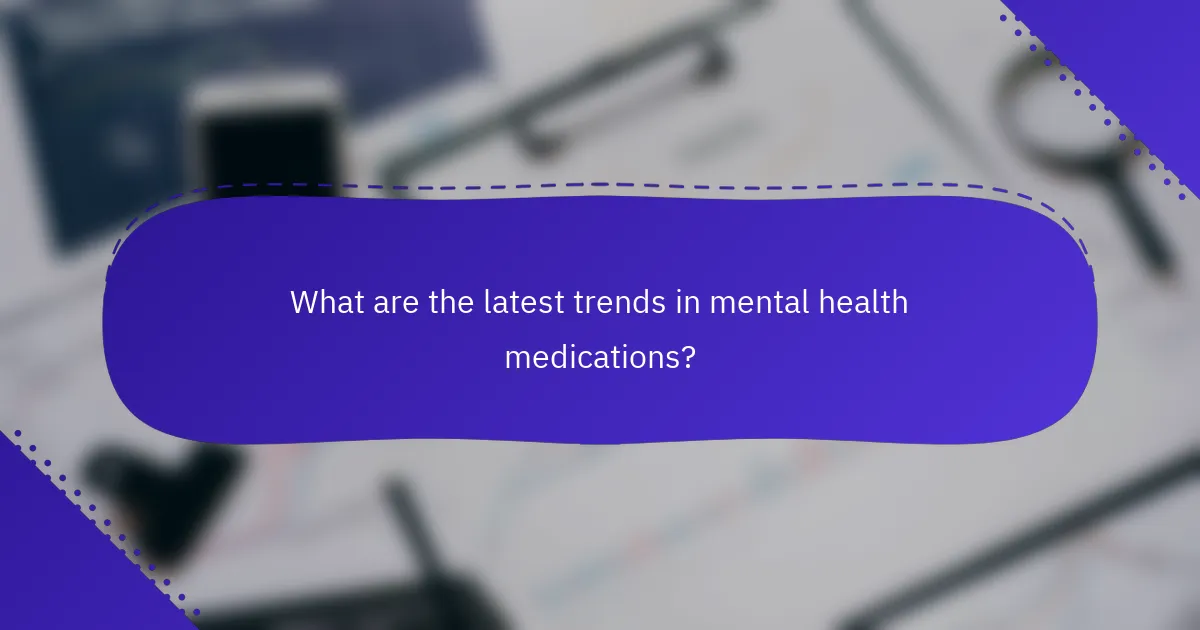
What are the latest trends in mental health medications?
The latest trends in mental health medications focus on personalized treatment plans and the integration of technology in therapeutic practices. These advancements aim to enhance the effectiveness of medications like antidepressants, anxiolytics, and mood stabilizers by tailoring them to individual patient needs.
Personalized medicine approaches
Personalized medicine in mental health involves customizing treatment based on a patient’s genetic profile, lifestyle, and specific symptoms. This approach can lead to more effective medication choices, reducing trial-and-error periods often associated with finding the right antidepressant or anxiolytic.
For example, pharmacogenomic testing can help determine how a patient metabolizes certain medications, allowing healthcare providers to prescribe drugs that are more likely to be effective and have fewer side effects. This trend is gaining traction in many countries, including Lithuania, where healthcare providers are increasingly adopting these methods.
Integration of digital therapeutics
Digital therapeutics are software-based interventions designed to treat mental health conditions alongside traditional medications. These tools can include mobile apps for cognitive behavioral therapy or platforms that provide guided mindfulness exercises, enhancing the overall treatment experience.
Research indicates that combining digital therapeutics with medications can improve patient outcomes significantly. For instance, a patient taking mood stabilizers might also use an app that offers daily mood tracking and coping strategies, leading to better management of their condition. As technology continues to evolve, these integrations are expected to become more commonplace in mental health treatment.






